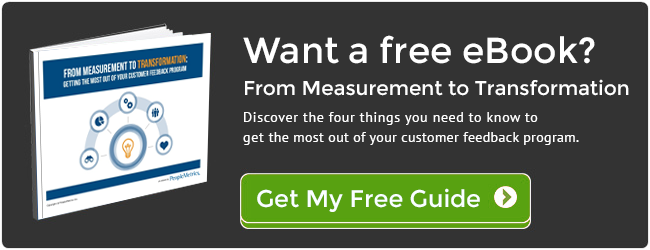A Quick Note. We've revisited this article and the differences between customer satisfaction metrics. You can check out our two updates here:
Or of course, you can continue with this article. Thanks!
“A science is as mature as its measurement tools,” Louis Pasteur once said. The concept applies to the business world as well. In order to survive, companies must retain customers. The tricky part is figuring out which measurement tools can be used to effectively assess, predict, and improve customer loyalty. Since the 1980s, customer satisfaction has been a popular measurement tool for improving retention. In the intervening decades, however, many business experts have questioned the importance of customer satisfaction, pointing out its weak impact on loyalty. These days, many organizations are instead tracking Customer Engagement. Following a brief history of customer feedback metrics, this article will discuss why Customer Engagement is an especially powerful “measuring stick” in the current market.
In the early days of customer experience research, customer loyalty was defined according to past consumer behavior. This was a problematic approach because it could not predict how customers would behave in the future. Who knew why these customers were loyal? Was it due to good deals or purchase rewards? In this sense, loyalty only indicated that customers hadn’t left yet; it couldn’t help predict whether they would stick with a company for the long term.
For some time, customer satisfaction was seen as the solution to the customer loyalty problem. R.L. Oliver’s Expectations Confirmation Theory held that customer satisfaction could be defined by measuring the gap between the customer’s expectations and his or her perception of whether those expectations had been met. Satisfied customers were those who perceived their expectations had been met or exceeded by a certain company’s goods or services. Measurement strategies such as SERVQUAL were developed to help companies determine customer satisfaction. Extremely satisfied customers, it was thought, would continue to buy goods and services, thereby creating brand stability and growing future profits.
However, it soon became clear that marketers had been chasing the wrong goal. In the late ‘90s and early ‘00s, researchers discovered that extremely satisfied customers were only slightly more likely to stay with a firm than moderately satisfied customers. In a 1995 Harvard Business Review article, Thomas Jones and Earl Sasser Jr. pointed out that “satisfied customers defect.” Indeed, numerous studies debunked the clout of customer satisfaction. For example, one analysis of banking customers found that 6% of “extremely satisfied” customers closed their accounts—nearly identical to the 5.8% departure rate for less satisfied customers. In other words, it was discovered that efforts to improve customer satisfaction provided a very low ROI.
Customer Engagement came on the scene when researchers included emotion as an important driver of the customer experience. Customer satisfaction was a functional measurement; it examined customer feedback on tangible, rational outcomes such as price. When a less expensive product appeared, customers were likely to switch providers. In contrast, Customer Engagement included emotional facets of the purchasing experience; it incorporated how consumers felt. Research verified that this was an important distinction; fully engaged customers were far more loyal than less engaged customers. In other words, achieving higher engagement provides a handsome ROI. The banking study mentioned earlier found that just 3.8% of fully engaged customers closed their accounts.
Customer Engagement may be used to pursue customer loyalty because fully engaged customers feel an emotional investment in the brand and its employees. Compared to customer satisfaction, customer engagement is a superior measurement tool for growing retention and other business outcomes such as profits and ROI. Indeed, PeopleMetrics’ Most Engaged Customer study has shown that businesses with higher engagement levels also enjoy higher profits, ROI, and share-of-market. Customer Engagement vs. Customer Satisfaction? When you consider the research, the choice is clear. Customer Engagement is the best tool for measuring the customer experience.
* * *
 PeopleMetrics is focused on helping clients create customer-centric cultures. Want to learn more about what we do? Click the button below to schedule time to chat with us. We can talk about your current customer experience strategy, where you want to go, or anything else that comes to mind!
PeopleMetrics is focused on helping clients create customer-centric cultures. Want to learn more about what we do? Click the button below to schedule time to chat with us. We can talk about your current customer experience strategy, where you want to go, or anything else that comes to mind!




%20(1).png)